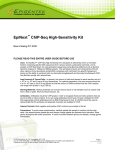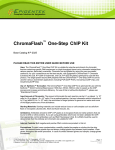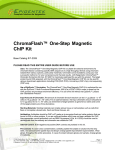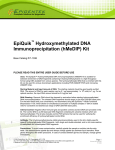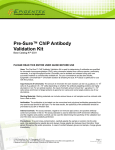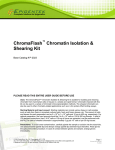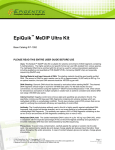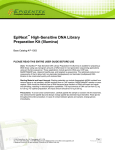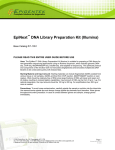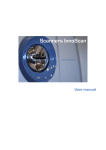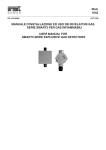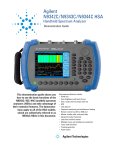Download ChromaFlash High-Sensitivity ChIP Kit
Transcript
EPIGENTEK Complete Solutions for Epigenetics ChromaFlash™ High-Sensitivity ChIP Kit Base Catalog # P-2027 PLEASE READ THIS ENTIRE USER GUIDE BEFORE USE Uses: The ChromaFlash™ High-Sensitivity ChIP Kit is suitable for selective enrichment of a chromatin fraction containing specific DNA sequences which is in a high throughput format with high sensitivity and specificity using various mammalian cell/tissues. The optimized protocol and kit components reduce non-specific background ChIP levels to allow capture of low abundance protein/transcription factors and increased specific enrichment of target protein/DNA complexes. The target protein bound DNA prepared with the ChromaFlash™ High-Sensitivity ChIP Kit can be used for various downstream applications including PCR (ChIP-PCR), microarrays (ChIP-on-chip), and sequencing (ChIP-seq). Input Amount of Tissue/Cells: In general, the amount of cells and tissues for each reaction can be 2 x 103 to 1 x 106 and 0.5 mg to 50 mg, respectively. For optimal preparation, the input amount should be 1 to 2 x 105 cells or 10 to 20 mg tissues since the enrichment of target proteins to genome loci may vary. For the target proteins that are low abundance transcription factors, the input amount should be 5 to 6 x 105 cells or 50-60 mg tissues. Starting Materials: Starting materials can include various tissue or cell samples such as cells from flask or plate cultured cells, fresh and frozen tissues, etc. Antibodies: Antibodies should be ChIP or IP grade in order to recognize fixed and native proteins that are bound to DNA or other proteins. If you are using antibodies which have not been validated for ChIP, then appropriate control antibodies such as RNA Polymerase II (Cat. # A -2032) should be used to demonstrate that the antibody and prepared chromatin are suitable for ChIP. Internal Controls: Both negative and positive ChIP controls are provided in this kit. Precautions: To avoid cross-contamination, carefully pipette the sample or solution into the tube/ wells. Use aerosol-barrier pipette tips and always change pipette tips between liquid transfers. Wear gloves throughout the entire procedure. In case of contact between gloves and sample, change gloves immediately. 110 Bi County Blvd. Ste. 122, Farmingdale, NY 11735 Tel: 1-877-374-4368 ■ Fax: 1-718-484-3956 ■ E-mail: [email protected] ■ Web: www.epigentek.com © Epigentek Group Inc. All rights reserved. Products are for research use only. Page 1 Printed 2015-07-30 P-2027 EPIGENTEK Complete Solutions for Epigenetics KIT CONTENTS Component 24 reactions Cat. #P-2027-24 48 reactions Cat. #P-2027-48 Storage Upon Receipt WB (Wash Buffer) 25 ml 2 x 25 ml 4°C AB (Antibody Buffer) 3 ml 6 ml 4°C LB (Lysis Buffer) 14 ml 28 ml RT CB (ChIP Buffer) 6 ml 12 ml 4°C DRB (DNA Release Buffer) 8 ml 16 ml RT DBS (DNA Binding Solution) 7 ml 14 ml RT BS (Blocker Solution) 2 ml 4 ml 4°C DEB (DNA Elution Buffer) 1 ml 2 ml RT Enrichment Enhancer* 55 µl 110 µl -20°C Protease Inhibitor Cocktail (PIC)* 30 µl 60 µl 4°C Non-Immune IgG (1 mg/ml)* 10 µl 20 µl 4°C Anti-RNA Polymerase II (1 mg/ml)* 8 µl 16 µl 4°C Proteinase K (10 mg/ml)* 60 µl 120 µl 4°C RNase A (10 mg/ml)* 30 µl 60 µl -20°C GAPDH Primer - Forward (20 µM)* 8 µl 16 µl 4°C GAPDH Primer - Reverse (20 µM)* 8 µl 16 µl 4°C 8-Well Assay Strips (With 1 Frame) 3 6 4°C 8-Well Strip Caps 3 6 RT Adhesive Covering Film 1 2 RT F-Spin Column 30 50 RT F-Collection Tube 30 50 RT User Guide 1 1 RT * Spin the solution down to the b ottom prior to use. SHIPPING & STORAGE The kit is shipped in two parts: the first part at ambient room temperature and the second part on frozen ice packs at 4°C. Upon receipt: (1) Store Enrichment Enhancer and RNase A at -20°C , Store WB, AB, CB, BS, Protease Inhibitor Cocktail, Non-Immune IgG, Anti-RNA Polymerase II, Proteinase K, GAPDH Primer – Forward, GADPH Primer – Reverse, and 8-Well Assay Strips (With 1 Frame) at 4°C away from light; (2) Store remaining components at room temperature away from light. All components of the kit are stable for 6 months from the date of shipment, when stored properly. Note: Check if, WB and CB contain salt precipitates before use. If so, briefly warm at room temperature or 37°C and shak e the buffer until the salts are re-dissolved. 110 Bi County Blvd. Ste. 122, Farmingdale, NY 11735 Tel: 1-877-374-4368 ■ Fax: 1-718-484-3956 ■ E-mail: [email protected] ■ Web: www.epigentek.com © Epigentek Group Inc. All rights reserved. Products are for research use only. Page 2 Printed 2015-07-30 P-2027 EPIGENTEK Complete Solutions for Epigenetics MATERIALS REQUIRED BUT NOT SUPPLIED Sonicator Vortex mixer Dounce homogenizer with small clearance pestle Variable temperature waterbath or incubator oven Thermocycler with 48 or 96-well block Centrifuge including desktop centrifuge (up to 14,000 rpm) Adjustable pipette and multiple-channel pipette Aerosol resistant pipette tips 0.2 ml or 0.5 ml PCR vials Orbital shaker 1.5 ml microcentrifuge tubes 15 ml conical tube Cells or tissues Antibodies of interest Cell culture medium 37% formaldehyde (if cross-linked) 1.25 M glycine solution (if cross-linked) 100% ethanol 1X PBS GENERAL PRODUCT INFORMATION Quality Control: Each lot of the ChromaFlash™ High-Sensitivity ChIP Kit is tested against predetermined specifications to ensure consistent product quality. Epigentek guarantees the performance of all products in the manner described in our product instructions. Product Warranty: If this product does not meet your expectations, simply contact our technical support unit or your regional distributor. We also encourage you to contact us if you have any suggestions about product performance or new applications and techniques. 110 Bi County Blvd. Ste. 122, Farmingdale, NY 11735 Tel: 1-877-374-4368 ■ Fax: 1-718-484-3956 ■ E-mail: [email protected] ■ Web: www.epigentek.com © Epigentek Group Inc. All rights reserved. Products are for research use only. Page 3 Printed 2015-07-30 P-2027 EPIGENTEK Complete Solutions for Epigenetics Safety: Suitable lab coat, disposable gloves, and proper eye protection are required when working with this product. Product Updates: Epigentek reserves the right to change or modify any product to enhance its performance and design. The information in this User Guide is subject to change at any time without notice. Thus, only use the User Guide that was supplied with the kit when using that kit. Usage Limitation: The ChromaFlash™ High-Sensitivity ChIP Kit is for research use only and is not intended for diagnostic or therapeutic application. Intellectual Property: The ChromaFlash™ High-Sensitivity ChIP Kit and methods of use contain proprietary technologies by Epigentek. A BRIEF OVERVIEW Protein-DNA interaction plays a critical role for cellular functions such as signal transduction, gene transcription, chromosome segregation, DNA replication and recombination, and epigenetic silencing. Identifying the genetic targets of DNA binding proteins and knowing the mechanisms of protein-DNA interaction is important for understanding cellular processes. Chromatin immunoprecipitation (ChIP) offers an advantageous tool for studying protein-DNA interactions. It allows for the detection of a specific protein bound to a specific gene sequence in living cells using PCR (ChIP-PCR), microarrays (ChIP-chip), or sequencing (ChIP-seq). For example, measurement of the amount of methylated histone H3 at lysine 9 (meH3-K9) associated with a specific gene promoter region under various conditions can be achieved through a ChIP-PCR assay, while the recruitment of meH3-K9 to the promoters on a genome-wide scale can be detected by ChIP-chip or ChIP-sequencing. In particular, ChIP that uses antibodies directly against various transcription factors (TF) for genome-wide transcription factor binding site analysis by next generation sequencing is in high demand. Such analysis requires that ChIPed DNA contain minimal background for reliably identifying true TF-enriched regions. High background in ChIP is mainly caused by the following weaknesses: ineffective wash buffer, insufficient cross-link reversal, inappropriate DNA fragment length and residual RNA interference. Thus, for effectively capturing TF/DNA complexes which are often in low abundance, an ideal ChIP method requires having maximum sensitivity with minimized background levels. This method should also be able to enrich highly abundant protein/DNA complexes using a small amount of cells or tissues in a high throughput format. Epigentek’s ChromaFlash™ High-Sensitivity ChIP Kit is designed to achieve these goals by maximizing sensitivity and minimizing non-specific background signals. The ChromaFlash™ High-Sensitivity ChIP Kit has the following advantages: Optimized buffers and protocol allow minimal ChIP background by overcoming the weaknesses that cause non-specific enrichment, thereby increasing sensitivity and specificity of the ChIP reaction. Increased antibody selectivity and capture efficiency through the use of unique chimeric proteins containing the maximum number of IgG binding domains coated on the strip-wells. This allows strong binding of any IgG subtype antibodies within a wide pH range regardless if they are in monoclonal or polyclonal form. 96-well plate format makes the assay flexible. Either (a) manual with one single reaction each time; or (b) high throughput with 24-48 reactions each time. 110 Bi County Blvd. Ste. 122, Farmingdale, NY 11735 Tel: 1-877-374-4368 ■ Fax: 1-718-484-3956 ■ E-mail: [email protected] ■ Web: www.epigentek.com © Epigentek Group Inc. All rights reserved. Products are for research use only. Page 4 Printed 2015-07-30 P-2027 EPIGENTEK Complete Solutions for Epigenetics Highly efficient enrichment. The enrichment ratio of positive to negative control is > 500. An extremely low number of cells (as low as 2,000 cells per ChIP reaction) can be used for enriching highly abundant protein/DNA complexes. High reproducibility. Pre-optimized ChIP conditions make the ChIP procedure consistent. Wide downstream analysis compatibility. Compatible with various downstream analysis workflows including ChIP-PCR, ChIP-on-chip, and ChIP-seq. PRINCIPLE & PROCEDURE The ChromaFlash™ High-Sensitivity ChIP Kit contains all necessary reagents required for carrying out a successful chromatin immunoprecipitation starting from mammalian cells or tissues. This kit includes a positive control antibody (RNA polymerase II), a negative control non-immune IgG, and GAPDH primers that can be used as a positive control to demonstrate the efficacy of the kit reagents and protocol. RNA polymerase II is considered to be enriched in the GAPDH gene promoter that is expected to be undergoing transcription in most growing mammalian cells and can be immunoprecipitated by RNA polymerase II antibody but not by non-immune IgG. Immunoprecipitated DNA is then cleaned, released, and eluted. Eluted DNA can be used for various downstream applications such as ChIP-PCR, ChIP-on-chip, and ChIP-seq. Schematic Procedure for Using the ChromaFlash High-Sensitivity ChIP Kit (P-2027) 110 Bi County Blvd. Ste. 122, Farmingdale, NY 11735 Tel: 1-877-374-4368 ■ Fax: 1-718-484-3956 ■ E-mail: [email protected] ■ Web: www.epigentek.com © Epigentek Group Inc. All rights reserved. Products are for research use only. Page 5 Printed 2015-07-30 P-2027 EPIGENTEK Complete Solutions for Epigenetics Relative Enrichement Fold 80 70 60 Non-immune IgG ER-alpha antibody 50 40 30 20 10 0 0 50,000 500,000 Cell Number Low abundance protein enrichment: Sheared chromatin isolated from different numbers of MCF-7 cells w as used for ChIP-qPCR analysis of ER-a enrichment in TFF1 promoters using the ChromaFlash High-Sensitivity ChIP Kit (Cat. No. 2027 and the EpiQuik Quantitative PCR Fast Kit (Cat. No. P-1029). Fig 3. High abundance protein enrichment: Sheared chromatin isolated from different numbers of MBD-231 cells w as used for ChIP-qPCR analysis of RNA polymerase II enrichment in GAPDH promoters using the ChromaFlash HiSensitivity ChIP Kit (Cat. No. P-2027) and EpiQuik Quantitative PCR Fast Kit (Cat. No. P-1029). 110 Bi County Blvd. Ste. 122, Farmingdale, NY 11735 Tel: 1-877-374-4368 ■ Fax: 1-718-484-3956 ■ E-mail: [email protected] ■ Web: www.epigentek.com © Epigentek Group Inc. All rights reserved. Products are for research use only. Page 6 Printed 2015-07-30 P-2027 EPIGENTEK Complete Solutions for Epigenetics ASSAY PROTOCOL For the best results, please read the protocol in its entirety prior to starting your experiment. 1. Preparation of Working Buffers and Solutions a. Prepare Working Lysis Buffer by adding 6 µl of Protease Inhibitor Cocktail to every 10 ml of LB (Lysis Buffer) b. Prepare Working CB ChIP buffer by adding 1 µl of Protease Inhibitor Cocktail to every 1 ml of CB (ChIP Buffer). 2. Antibody Binding to Assay Strip Wells a. Predetermine the number of Assay Strip Wells required for your experiment. Carefully remove any unneeded strip wells from the plate frame and place them back in the bag (seal the bag tightly and store at 4°C). b. Set up the antibody binding reactions by adding the reagents to each well according to the following chart: Reagents Sample Positive Control Negative Control AB (Antibody Buffer) Your Antibodies 50-80 µl 0.5-2 µl 50-80 µl 0 50-80 µl 0 Anti-RNA Polymerase II 0 0.8 µl 0 Non-Immune IgG 0 0 0.8 µl Note: The final amount of each component should be (a) antibodies of interest: 0.8 µg/well; (b) RNA Polymerase II: 0.8 µg/well; and (c) non-immune IgG: 0.8 µg/well. The amounts of the positive control (Anti-RNA Polymerase II) and negative control (Non-Immune IgG) are sufficient for matched use with samples if two antibodies are used for each sample or one antibody is used for two of the same samples. If using one antibody of interest for each sample with matched use of the positive and negative control, extra RNA Polymerase II, Non-Immune IgG and 8Well Strips required can be separately obtained from Epigentek. c. Seal the wells with Adhesive Covering Film Strips and incubate the wells at room temperature for 60-90 min on an orbital shaker (100 rpm). Meanwhile, perform the steps from Section 3 “Cell Collection and Cross-Linking” to Section 5 “Chromatin Shearing”. 3. Cell Collection and Cross-Linking 3.1. For Monolayer or Adherent Cells: a. Grow cells (treated or untreated) to 80%-90% confluence on a 6 well plate or 100 mm dish (the number of cultured MDA-231 cancer cells on an 80-90% confluent plate is listed in the table below as 110 Bi County Blvd. Ste. 122, Farmingdale, NY 11735 Tel: 1-877-374-4368 ■ Fax: 1-718-484-3956 ■ E-mail: [email protected] ■ Web: www.epigentek.com © Epigentek Group Inc. All rights reserved. Products are for research use only. Page 7 Printed 2015-07-30 P-2027 EPIGENTEK Complete Solutions for Epigenetics a reference), then trypsinize and collect them into a 15 ml conical tube. Count the cells in a hemocytometer. Container 96-well plate 24-well plate 12-well plate 6-well plate 60 mm dish 100 mm dish 150 mm dish Cell Number (x 105) 0.3-0.6/well 1-3/well 3-6/well 5-10/well 20-30 50-100 150-180 b. Centrifuge the cells at 1000 rpm for 5 min. Discard the supernatant. c. Wash cells with 10 ml of PBS once by centrifugation at 1000 rpm for 5 min. Discard the supernatant. Note: For cells that are not cross-linked, go directly to Step 3.1.i after Step 3.1.c. d. Add 9 ml fresh cell culture medium containing formaldehyde to a final concentration of 1% (i.e., add 270 µl of 37% formaldehyde to 10 ml of cell culture medium) to cells. e. Incubate at room temperature (20-25°C) for 10 min on a rocking platform (50-100 rpm). f. Add 1 ml of 1.25 M Glycine for every 9 ml of cross-link solution. g. Mix and centrifuge at 1000 rpm for 5 min. h. Remove medium and wash cells once with 10 ml of ice-cold PBS by centrifuging at 1000 rpm for 5 min. Discard the supernatant. i. Add Working Lysis Buffer to re-suspend the cell pellet (200 µl/1x106 cells) and incubate on ice for 10 min. Note: If the total solution volume is less than 1.5 ml, transfer the solution to a 1.5 ml microtube. j. Vortex vigorously for 10 sec and centrifuge at 3000 rpm for 5 min. Then go to Step 4a. 3.2. For Suspension Cells: a. Collect cells (treated or untreated) into a 15 ml conical tube. (2 x105 to 5x105 cells are required for each ChIP reaction). Count cells in a hemocytometer. b. Centrifuge the cells at 1000 rpm for 5 min. Discard the supernatant. c. Wash cells with 10 ml of PBS once by centrifugation at 1000 rpm for 5 min. Discard the supernatant. Note: For cells that are not cross-linked, go directly to Step 3.2.i after Step 3.2.c. d. Add 9 ml fresh cell culture medium containing formaldehyde to a final concentration of 1% (i.e., add 270 µl of 37% formaldehyde to 10 ml of cell culture medium) to cells. e. Incubate at room temperature (20-25°C) for 10 min on a rocking platform (50-100 rpm). f. Add 1 ml of 1.25 M glycine for every 9 ml of cross-link solution. 110 Bi County Blvd. Ste. 122, Farmingdale, NY 11735 Tel: 1-877-374-4368 ■ Fax: 1-718-484-3956 ■ E-mail: [email protected] ■ Web: www.epigentek.com © Epigentek Group Inc. All rights reserved. Products are for research use only. Page 8 Printed 2015-07-30 P-2027 EPIGENTEK Complete Solutions for Epigenetics g. Mix and centrifuge at 1000 rpm for 5 min. h. Remove medium and wash cells once with 10 ml of ice-cold PBS by centrifuging at 1000 rpm for 5 min. Discard the supernatant. i. Add Working Lysis Buffer to re-suspend the cell pellet (200 µl/1x106 cells) and incubate on ice for 10 min. Note: If the total solution volume is less than 1.5 ml, transfer the solution to a 1.5 ml microtube. j. Vortex vigorously for 10 sec and centrifuge at 3000 rpm for 5 min. Then go to Step 4a. 3.3. For Tissues: a. Put the tissue sample into a 60 or 100 mm plate. Remove unwanted tissue such as fat and necrotic material from the sample. b. Weigh the sample and cut the sample into small pieces (1-2 mm3) with a scalpel or scissors. Note: For tissues that are not cross-linked, go directly to Step 3.3.j after Step 3.3.b. c. Transfer tissue pieces to a 15 ml conical tube. d. Prepare cross-link solution by adding formaldehyde to cell culture medium to a final concentration of 1% (e.g., add 270 µl of 37% formaldehyde to 10 ml of culture medium). e. Add 1 ml of cross-link solution for every 50 mg tissues. f. Incubate at room temperature for 15-20 min on a rocking platform. g. Add 1 ml of 1.25 M glycine for every 9 ml of cross-link solution. h. Mix and centrifuge at 800 rpm for 5 min. Discard the supernatant. i. Wash cells with 10 ml of ice-cold PBS once by centrifugation at 800 rpm for 5 min. Discard the supernatant. j. Transfer tissue pieces to a Dounce homogenizer. k. Add 0.5 ml Working Lysis Buffer for every 50 mg of tissues. l. Disaggregate tissue pieces with 20-40 strokes. m. Transfer homogenized mixture to a 15 ml conical tube and centrifuge at 3000 rpm for 5 min at 4°C. If total mixture volume is less than 2 ml, transfer mixture to a 2 ml vial and centrifuge at 5000 rpm for 5 min at 4°C. Then go to Step 4a. 4. Cell Lysis and Chromatin Extraction a. Carefully remove supernatant. b. Add CB (ChIP Buffer) to re-suspend the chromatin pellet (100 µl/1x106 cells or 50 mg tissue, 500 µl maximum for each vial). 110 Bi County Blvd. Ste. 122, Farmingdale, NY 11735 Tel: 1-877-374-4368 ■ Fax: 1-718-484-3956 ■ E-mail: [email protected] ■ Web: www.epigentek.com © Epigentek Group Inc. All rights reserved. Products are for research use only. Page 9 Printed 2015-07-30 P-2027 EPIGENTEK Complete Solutions for Epigenetics c. Transfer the chromatin lysate to a 1.5 ml vial and incubate on ice for 10 min and vortex occasionally. 5. Chromatin Shearing a. Resuspend the chromatin lysate by vortexing. b. Shear chromatin using one of the following methods: Waterbath Sonication: Epigentek EpiSonic 1100 (Epigentek Cat No. EQC-1100): Use 50 µl of chromatin lysate per 0.2 ml tube or per PCR plate well. Shear 20 cycles under cooling condition, 15 seconds On, 30 seconds Off, each at 170-190 watts. For more detailed information of use, please see the “Chromatin Shearing Protocol” for EpiSonic 1100. If using other waterbath sonicators, please follow the supplier’s instruction. Probe-based Sonication: Use 300 µl of chromatin lysate per 1.5 ml microcentrifuge tube. As an example, sonication can be carried out with a microtip attached to a Branson 450 sonifier, set to 25% power output. Sonicate 3-4 pulses of 10-15 seconds each, followed by 30-40 seconds rest on ice between each pulse. (The conditions of cross-linked DNA shearing can be optimized based on cells and sonicator equipment). Note: When probe-based sonication is carried out, the shearing effect may be reduced if foam is formed in chromatin sample solution. Under this condition, discontinue sonication and centrifuge the sample at 4˚C at 12,000 rpm for 3 min to remove the air bubbles. The isolated chromatin can also be sheared with various enzyme-based methods. Optimization of the shearing conditions, for example enzyme concentration and incubation time, is needed in order to use enzyme-based methods. c. Centrifuge at 12,000 rpm at 4°C for 10 min after shearing. d. Transfer supernatant to a new vial. The chromatin solution can now be used immediately or stored at –80°C after aliquoting appropriately until further use. Avoid multiple freeze/thaw cycles. Note: The size of sonicated chromatin should be verified before starting the immunoprecipitation step. The following steps can be carried out to isolate DNA for gel analysis of DNA fragment size: (1) add 25 µl of each chromatin sample to a 0.2 ml PCR tube followed by adding 25 µl of DRB (DNA Release Buffer) and 2 µl of Proteinase K; (2) incubate the sample at 60°C for 30min followed by incubating at 95°C for 10 min; (3) spin the solution down to the bottom; (4) transfer supernatant to a new 0.2 m l PCR vial. Use 30-40 µl for DNA fragment size analysis along with a DNA mark er on a 1-2% agarose gel; and (5) Stain with ethidium bromide or other fluorescent dye for DNA and visualize it under ultraviolet light. The length of sheared DNA should be between 100-700 bps with a peak size of 300 bps. 110 Bi County Blvd. Ste. 122, Farmingdale, NY 11735 Tel: 1-877-374-4368 ■ Fax: 1-718-484-3956 ■ E-mail: [email protected] ■ Web: www.epigentek.com © Epigentek Group Inc. All rights reserved. Products are for research use only. Page 10 Printed 2015-07-30 P-2027 EPIGENTEK Complete Solutions for Epigenetics 6. Preparation of ChIP Reaction a. Carefully peel away the Adhesive Covering Film on the antibody binding wells (from Step 2b) to avoid contamination between each well. b. Remove the antibody reaction solution and Non-Immune IgG solution from each well and wash the wells one time with 150 ul of CB (ChIP Buffer). c. Set up the ChIP reactions by adding the reagents to the wells that are bound with antibodies (sample and positive control wells) or IgG (negative control well) according to the following chart: Reagents CB ChIP Buffer Sample 48-78 µl Positive Control 48-78 µl Negative Control 48-78 µl Chromatin Enrichment Enhancer 10-40 µl 2 µl 10-40 µl 2 µl 10-40 µl 2 µl BS Blocker Solution 10 µl 10 µl 10 µl Total 100 µl 100 µl 100 µl Note: The final amount of chromatin should be 2 µg/well (2 X 105 cells may yield 1 µg of chromatin); Sonicated chromatin can be further diluted with CB (ChIP Buffer) to desired concentration. For histone samples with sufficient chromatin (> 0.5 µg), the Enrichment Enhancer is not required and 50-80 µl of CB (ChIP Buffer) can be used. For low abundance targets, 2 µl of Enrichment Enhancer and 88 µl of chromatin can be used without adding CB (ChIP Buffer). Freshly prepared chromatin can be directly used for the reaction. Frozen chromatin samples should be thawed quick ly at RT and then placed on ice before use. Store remaining c hromatin samples at -20°C or –80°C if they will be not used within 8 hours. Input DNA control is only used for estimating the enrichment efficiency of ChIP and is generally not necessary since the positive and negative control can be used for estimating the same objective more accurately. If you would lik e to include the input DNA control, the purified input DNA prepared at Step 5d “Note” can be used. d. Cap wells with Strip Caps and incubate at room temperature for 60-90 min on an orbital shaker (100 rpm). For low abundance targets, the incubation time should extend to 2-3 hours or at 4°C overnight. 7. Washing of the Reaction Wells a. Carefully remove the solution and discard from each well. b. Wash each well with 200 µl of the WB each time for a total of 4 washes. Allow 2 minutes on an orbital shaker (100 rpm) for each wash. Pipette wash buffer out from the wells. c. Wash each well with 200 µl of the DRB one time by pipetting DRB in and out of the well. 8. Reversal of Cross-Links, Release and Purification of DNA a. Prepare RNase A solution by adding 1 µl of RNase A to 40 µl of DRB. 110 Bi County Blvd. Ste. 122, Farmingdale, NY 11735 Tel: 1-877-374-4368 ■ Fax: 1-718-484-3956 ■ E-mail: [email protected] ■ Web: www.epigentek.com © Epigentek Group Inc. All rights reserved. Products are for research use only. Page 11 Printed 2015-07-30 P-2027 EPIGENTEK Complete Solutions for Epigenetics b. Add 40 µl of DRB-RNase A to each well, and then cover with Strip Caps. c. Incubate the wells at 42°C for 30 min. d. Add 2 µl of Proteinase K to each of the wells and re-cap the wells. e. Incubate the wells at 60°C for 45 min. f. Quickly transfer the DNA solution from each well to 0.2 ml strip PCR tubes. Cap the PCR tubes. g. Incubate the PCR tubes containing DNA solution at 95°C for 15 min in a thermolcycler. h. Place the PCR tubes at room temperature. If liquid is collected on the inside of the caps, briefly spin the liquid down to the bottom. DNA prepared at this step can be directly used for PCR or go to Step 8.i. for further purification for use in ChIP-Seq. i. Place a spin column into a 2 ml collection tube. Add 200 µl of DBS (DNA Binding Solution) to the samples and transfer the mixed solution to the column. Centrifuge at 12,000 rpm for 30 seconds. j. Add 200 µl of 90% ethanol to the column, centrifuge at 12,000 rpm for 30 seconds. Remove the column from the collection tube and discard the flowthrough. k. Replace column to the collection tube. Add 200 µl of 90% ethanol to the column and centrifuge at 12,000 rpm for 30 seconds. l. Remove the column and discard the flowthrough. Replace column to the collection tube and wash the column again with 200 µl of 90% ethanol at 12,000 rpm for 1 min. m. Place the column in a new 1.5 ml vial. Add 20 µl of DEB (DNA Elution Buffer) directly to the filter in the column and centrifuge at 12,000 rpm for 30 seconds to elute the purified DNA. Purified DNA is now ready for PCR, ChIP-chip and ChIP-seq use or storage at –20°C. Note: For real time PCR analysis, we recommend the use of 1-2 µl of eluted DNA in a 20 µl PCR reaction. If input DNA will be used, it should be diluted 10 fold before adding to the PCR reaction. Control primers (110 bp, for human cells) included in the k it can be used as a positive control. For end point PCR, the number of PCR cycles may need to be optimized for better PCR results. In general, the amplification difference between “normal IgG control” and “positive control” may vary from 3 to 8 cycles, depending on experimental conditions. For ChIP-Seq, if sequencing is on MiSeq®, HiSeq™, Hiscan™ SQ or Genome Analyzer, ChIP DNA library can be constructed using our EpiNext™ DNA Library Preparation Universal Kit (Illumina) (Cat# P-1051) or Illumina ChIP-seq DNA Sample Prep Kit. For sequencing on other sequencing platforms, appropriate library preparation methods that are compatible with these platforms should be selected accordingly. In general, at least 10 ng of ChIPed DNA is required for ChIP DNA library construction. This amount can easily be generated for high abundance targets from a single ChIP reaction well. However this may be difficult for low abundance target enrichment. For low abundance targets, we recommend pooling the DNA solution from several wells with the same ChIP reaction to gain 10 ng or more DNA amount. We also recommend performing qPCR to verify the quality of the ChIPed DNA. 110 Bi County Blvd. Ste. 122, Farmingdale, NY 11735 Tel: 1-877-374-4368 ■ Fax: 1-718-484-3956 ■ E-mail: [email protected] ■ Web: www.epigentek.com © Epigentek Group Inc. All rights reserved. Products are for research use only. Page 12 Printed 2015-07-30 P-2027 EPIGENTEK Complete Solutions for Epigenetics PCR ANALYSIS Real Time PCR Primer Design The primers designed should meet the criteria for real time PCR. For example, the covered sequence region should be 50-150 bp in length. G/C stretches at 3’ ends of primers should be avoided. PCR Reaction Real time PCR can be performed using your own proven method. For your convenience and the best results, Epigentek offers the EpiQuik™ Quantitative PCR Fast Kit (Cat. No. P-1029) which is optimized for fast qPCR reactions. As an example, the protocol is presented below: Prepare the PCR Reactions Thaw all reaction components including master mix, DNA/RNA free water, primer solution and DNA template. Mix well by vortexing briefly. Keep components on ice while in use and return to –20˚C immediately following use. Add components into each well according to the following: Component Size (:l) Final Concentration Component Size (µl) Final Concentration EpiQuik™ Master Mix (2X) Forward Primer 10 µl 1X 1 µl 0.4-0.5 µM Reverse Primer DNA Template 1 µl 1-2 µl 0.4-0.5 µM 50 pg-0.1 µg DNA/RNA-Free H 2O 6-7 µl Total Volume 20 µl For the negative control, use DNA/RNA-free water instead of DNA template. Program the PCR Reactions Place the reaction plate in the instrument and set the PCR conditions as follows : Cycle Step Activation Temp 95°C Time 7 min Cycle 1 Cycling 95°C 55°C 72°C 10 sec 10 sec 8 sec 40 Final Extension 72° 1 min 1 Fold Enrichment Calculation Fold enrichment (FE) can be calculated by simply using a ratio of amplification efficiency of the ChIP sample over that of Non-Immune IgG. Amplification efficiency of RNA Polymerase II can be used as a positive control. FE % = 2(IgG CT – Sample CT) x 100% For example, if Ct for IgG is “38” and the sample is “34”, then… 110 Bi County Blvd. Ste. 122, Farmingdale, NY 11735 Tel: 1-877-374-4368 ■ Fax: 1-718-484-3956 ■ E-mail: [email protected] ■ Web: www.epigentek.com © Epigentek Group Inc. All rights reserved. Products are for research use only. Page 13 Printed 2015-07-30 P-2027 EPIGENTEK Complete Solutions for Epigenetics FE % = 2(38 – 34) x 100% = 1600% Endpoint PCR Primer Design The primers designed should meet the criteria for endpoint PCR. For example, the covered sequence region should be 100-400 bp in length. PCR primer design tools (e.g., Primer3Plus) can be used to help in the selection of appropriate primer pairs. PCR Reaction Endpoint PCR can be performed using your own proven method. It is important to stop the PCR reaction at the exponential phase by setting up an appropriate number of PCR cycles in order to make a reliable comparision of enrichment efficiency obtained from different ChIP reactions. Thus, the optimized number of PCR cycles should be determined empirically. PCR Product Analysis Endpoint PCR products can be analyzed by separating amplicons on a 1-2% agarose gel, followed by staining with ethidium bromide and visulizing with UV-illumination. TROUBLESHOOTING Problem Possible Cause Suggestion Little or no PCR products generated from both sample and positive control wells Poor chromatin quality due to insufficient amount of cells, or insufficient or over cross -linking. The optimal amount of chromatin obtained per ChIP reaction should be 24 µg (about 2-4 x 10 5 cells). Appropriate chromatin cross-linking is also required. Insufficient or overcrosslinking will cause DNA loss or increased background. During the cross-linking step of chromatin preparation, ensure that the cross linking time is within 10-15 min, the final concentration of formaldehyde is 1%, and the quench solution is 0.125 M glycine. Poor enrichment with antibody: some antibodies used in ChIP might not efficiently recognize fixed protein. Increase the antibody amount and use ChIP-grade antibodies validated for use in ChIP. Inappropriate DNA fragmenting condition. If chromatin is from a specific cell/tissue type, or is differently fixed, the shearing conditions should be optimized to allow DNA fragment size to be between 200800 bp. Incorrect temperature and/or insufficient time during DNA release. Ensure the incubation times and temperatures described in the protocol are followed correctly. 110 Bi County Blvd. Ste. 122, Farmingdale, NY 11735 Tel: 1-877-374-4368 ■ Fax: 1-718-484-3956 ■ E-mail: [email protected] ■ Web: www.epigentek.com © Epigentek Group Inc. All rights reserved. Products are for research use only. Page 14 Printed 2015-07-30 P-2027 EPIGENTEK Complete Solutions for Epigenetics Improper PCR conditions, including improper PCR programming, PCR reaction solutions, and/or primers. Ensure the PCR is properly programmed. If using a homebrew PCR reaction solution, check if each component is correctly mixed. If using a PCR commercial kit, check if it is suitable for your PCR. Confirm species specificity of primers. Primers should be designed to cover a short sequence region (70-150 bp) for more efficient and precise amplification of target DNA region (the binding site of the protein of interest). Improper sample storage. Chromatin sample should be stored at –80°C for no longer than 6 months, preferably less than 3 months. Avoid repeated freeze/thaw cycles. DNA samples should be stored at – 20°C for no longer than 6 months, preferably less than 3 months. No difference in signal intensity between negative and positive control wells Insufficient washing. Check if washing recommendations at each step is performed according to the protocol. If the signal intensity in the negative control is still high, washing stringency can be increased in the following ways: 1. Increase wash time at each wash step: after adding WB, leave it in the wells for 3-4 min and then remove it. 2. Add an additional one wash with WB, respectively: the provided volume of WB is sufficient for 4 extra washes for each sample. Too many PCR cycles; Plateau phase of amplification caused by excessive number of PCR cycles in endpoint PCR may mask the difference of signal intensity between negative contol and positive control. Decrease the number of PCR cycles (i.e., 32-35 cycles) to keep amplification at the exponential phase. This will reduce high background in endpoint PCR and allow differences in amplification to be seen. Real time PCR is another choice in such cases. Little or no PCR products generated from sample wells only Poor enrichment with antibody; Some antibodies used in ChIP might not efficiently recognize fixed protein. Increase the antibody amount and use ChIP-grade antibodies validated for use in ChIP. 110 Bi County Blvd. Ste. 122, Farmingdale, NY 11735 Tel: 1-877-374-4368 ■ Fax: 1-718-484-3956 ■ E-mail: [email protected] ■ Web: www.epigentek.com © Epigentek Group Inc. All rights reserved. Products are for research use only. Page 15 Printed 2015-07-30 P-2027 EPIGENTEK Complete Solutions for Epigenetics PCR primers are not optimized. Confirm species specificity of primers. Primers should be designed to cover a short sequence region (70-150 bp) for more efficient and precise amplification of target DNA region (the binding site of the protein of interest). RELATED PRODUCTS ChIP Reaction P-2002 P-2003 P-2014 P-2025 P-2026 EpiQuik™ Chromatin Immunoprecipitation Kit EpiQuik™ Tissue Chromatin Immunoprecipitation (ChIP) Kit EpiQuik™ Plant ChIP Kit ChromaFlash™ One-Step ChIP Kit ChromaFlash™ Magnetic One-Step ChIP Kit Chromatin Preparation and Cleanup P-2001 ChromaFlash™ Chromatin Extraction Kit P-2023 ChromaFlash™ Chromatin Isolation & Shearing Kit P-1006 DNA Concentrator Kit Sonication Instruments EQC-1100 EpiSonic™ Multi-Functional Bioprocessor 1100 PCR Analysis P-1029 EpiQuik™ Quantitative PCR Fast Kit DNA Library Prep P-1051 EpiNext™ DNA Library Preparation Kit (Illumina) For ChIP-grade antibodies, please search “chip-grade” at www.epigentek .com 110 Bi County Blvd. Ste. 122, Farmingdale, NY 11735 Tel: 1-877-374-4368 ■ Fax: 1-718-484-3956 ■ E-mail: [email protected] ■ Web: www.epigentek.com © Epigentek Group Inc. All rights reserved. Products are for research use only. Page 16 Printed 2015-07-30 P-2027
















